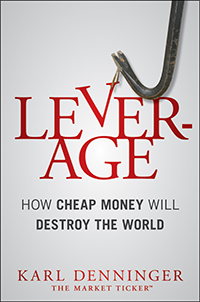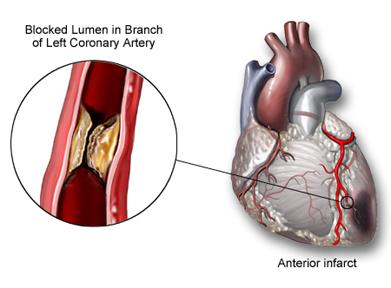If this proves up it is going to be an absolute disaster for everyone in the health field -- in fact, it will be as bad as the disaster that resulted from exposure of the fact that leeches were worthless in "treating disease."
Coronary Artery Disease, or "CAD" for short, has proceeded from the following general premises:
1. Cholesterol in the blood binds to sites of inflammation in the artery, treating it much like it would a splinter in your foot.
2. That process is cumulative and, over time, blocks more and more of the artery.
3. Eventually this produces a blockage that either breaks off (a stroke) or you have a heart attack due to insufficient blood delivery to the heart muscle.
In fact if you look around Google for "Coronary Artery Blockage image" you will find hundreds of images that look like this:
There's one problem -- they're all wrong.
The paper cited above points out the logical fallacies that have attached to the "common model" you're taught and that your doctor -- and cardiologist -- is using.
- This is a systemic disease, that is systemic inflammation is usually believed to be the root cause and it makes sense, except for one problem that this paper points out: The only place the arterial blockage tends to occur is in the cardiac arteries; the entire rest of the body appears to be either entirely unaffected or almost-entirely so. It is exceedingly improbable that systemic inflammation would leave all the other arteries in the body untouched yet selectively clog the ones around the heart. Indeed, every cardiologist knows this; where do you think they get arterial grafts from (usually veins in the leg) and how many of those do you think the average cardiologist has seen, and how many have asked "how come this one's not blocked too, given that it's a similar-sized blood vessel?"
- If high LDL-C levels produced CAD then removing the high LDL-C levels by any means (including drugs) would eliminate the disease. It does not; only about 30-40% of those at risk are "helped" and plenty of people with "normal" LDL-C levels get CAD. This means that the presence of LDL-C cannot be the cause of CAD since eliminating the presence of the alleged causative factor does not eliminate the disease.
- Invariably, as in the above image, the plaques are shown initiating at the arterial wall and growing inward. The problem is that this isn't what actually happens; the first depositions of LDL-C take place deep inside the arterial wall and there are few molecules present at the blood/wall boundary. This I was not aware of and you probably weren't either, given the above image that everyone has in their head that's ever looked at one along with the accompanying text. Guess what: That image and text is factually incorrect.
Now let's add some more facts to the mix that are discussed in the paper:
- The coronary arteries develop a multi-layer structure early in life through cellular differentiation that thickens until young adulthood, then stabilizes, maintaining itself thereafter. That is, this normal state develops in all humans over roughly the same time frame (immediate post-birth through age 30 or so.) Contrary to the common presentation the inner layer is not a single layer of cells; it is a multi-layer structure.
- There is a substance, proteogycan biglycan, that binds to LDL-C and is normally present in the outer layers of the coronary arterial wall. By contrast the inside layers are poor in this substance. However, the outer layers of the inside arterial wall cannot access LDL-C from the bloodstream flowing in the artery because the arterial wall is normally not vascularized -- that is, there are no capillaries bringing blood to it. Instead, oxygen and glucose reach these cells via direct diffusion. LDL-C is too large to diffuse through that distance in any material quantity irrespective of its presence in the blood.
- LDL-C does not accumulate starting at the inside arterial wall outwards. This effectively demolishes the claim that it is via the blood flowing in the artery and diffusion that such deposits are picked up and accumulate; it is logically inconsistent since to reach those outer layers the inner ones must be reached first!
- It is known that one of the reactions to oxygen starvation of cells is to stimulate vascularization. That is, when cell layers get too thick for diffusion to work any more they stimulate the development of capillaries to bring them oxygen and transport both glucose and waste.
- The appearance of vascularization always precedes the development of CAD and originates not from inside the inner arterial wall but rather from the outside in; in arteries where it is not present no plaque development occurs.
- This abnormal vascularization and concentration of LDL-C are observed in other tissues. Specifically, this has been observed in the cornea which is also normally not vascularized but, if it becomes so, fatty plaque formation occurs. This has been known for 50 years and yet has been ignored in the CAD "debate."
- Arterial plaques in the coronary arteries are more common in herbivores than carnivores, and occur in all eutherian (placenta-bearing) animals with a body mass comparable to or larger than humans. You've been told that CAD is a uniquely-human disease and meat-eating is more-dangerous in this regard than veganism. The claim that CAD is a human disease is a bald and knowing lie, and further herbivores are more susceptible to the disease than carnivorous eaters! So much for vegetarianism being protective against heart disease.
This paper roundly demolishes a number of claims that are made every day in the media and the medical establishment, and what's worse is that it completely decimates the balance of benefit and harm argument for the use of drugs to "lower cholesterol" such as statins because once the inner coronary arterial wall has become vascularized LDL-C will inevitably be picked up and accumulated.
Let's put forth what is directly attacked and, if this paper holds up, refuted:
- Coronary Artery Disease is a human condition. False; it is found in all placenta-bearing mammals of human or larger size.
- Coronary Artery Disease is a condition that is more-common and more-severe (or even exclusively present) in meat-eating animals. False; it is in fact more-common in herbivores than carnivores. That is, there is zero evidence that vegetarian eating is helpful and in fact the evidence among animals in general goes the other way.
- Coronary Artery Disease is caused by LDL-C. False; greatly attenuating LDL-C does not prevent the disease; it is at best 30-40% effective.
- Coronary Artery Disease begins with LDL-C carried in the arterial blood that diffuses through the inner arterial endothelium directly. Not likely; that is not a single-cell layer as commonly depicted, and the concentration of LDL-C is higher in the deeper layers, which is logically inconsistent with that claim. Further, CAD does not present in arteries that have not had the deeper layers vascularized which is logically inconsistent with the theory that LDL-C in the arterial blood deposits on or diffuses through the arterial wall.
The problem with what's presented here, from a medical perspective, is that if this paper proves up it doesn't leave you with a trillion dollar industry you can force people to spend money on by scaring them to death.
If in fact the growth of the inside layer of your coronary arteries in thickness is a risk factor that simply comes with time on the planet then given the inherent response of cells that become less-than-well supplied by oxygen (that is, to stimulate vascularization) there may be no actual cure available for this condition; it may simply be inherent in getting older, with some people more susceptible than others.
If, on the other hand, there is some sort of systemic insult responsible for the thickening of these inside walls beyond the limits of diffusion to provide transport that might be able to be addressed. The problem with such a belief is that you then have to find the same insult pathway -- whether from the same cause or not -- in the other mammals that also suffer from the condition. That becomes a rather serious problem since obviously other large placental mammals don't eat trans-fats or refined sugars, as just one example.
In short while this paper is a not a smoking gun as to cause it refutes a lot of false claims about coronary arterial disease and, if it holds up to scrutiny you may be witnessing the imminent destruction of a trillion-dollar a year scam.
Stay tuned.
PS: This paper's description is also consistent with why smoking promotes (but does not cause) coronary artery disease. Smoking raises CoHb levels, which in turn would tend to lead to cellular hypoxia, with the most-severe effects being in cells where the diffusion path is the longest. That, in turn, would be expected to promote vascularization..... Likewise, it explains the association between sleep apnea where depression of oxygen saturation has been documented and CAD -- an association that has been shown but I've yet to see a plausible scientific explanation as to why they're associated. This definitely appears to merit further study!



